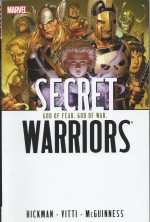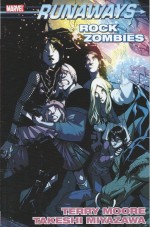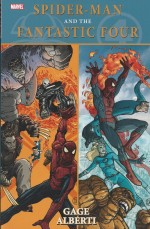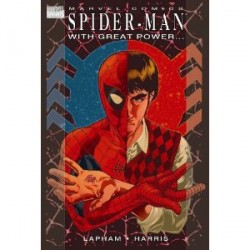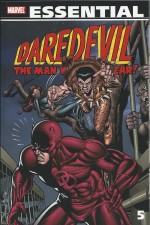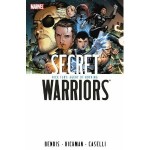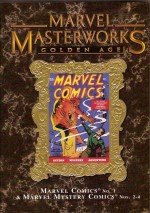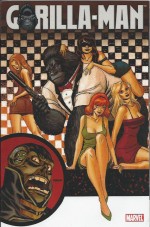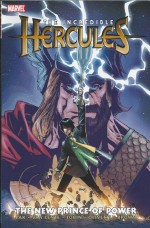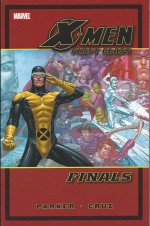
By Jeff Parker, Amilcar Pinna, Roger Cruz & Colleen Coover, Len Wein & Dave Cockrum (Marvel)
ISBN: 978-0-4051-3348-3
Radical perpetual change – or at least the appearance of such – is a cornerstone of modern comics. There must be a constant changing of the guard, a shifting of scene and milieu and, in latter times, a regular diet of death, resurrection and rebirth – all grounded in relatively contemporary terms and situations.
With a property as valuable as the X-Men such incessant remodelling is a necessarily good thing, even if you sometimes need a scorecard to keep up, and over the intervening decades the franchise has repeatedly represented, refashioned and updated the formative early epics by Stan Lee, Jack Kirby, Alex Toth, Roy Thomas and Werner Roth to give a solid underpinning to all the modern Mutant mayhem.
A case in point is this rather impressive and deliriously fun-filled restating of the Mutant paradigm from Marvel wherein the latest status quo gets the boot and a new beginning equates with a return to the good old days…
Most people who read comics have a passing familiarity with Marvel’s ever-changing X-Men franchise, and newcomers or occasional consumers won’t have too much trouble following the backstory, so let’s plunge in as the hostile world once more kicks sand in the faces of the planet’s most dangerous and reviled minority…
In 1963 The X-Men #1 introduced gloomy, serious Scott Summers/Cyclops, ebullient Bobby Drake/Iceman, wealthy golden boy Warren Worthington III/Angel, Jean Grey/Marvel Girl and erudite, brutish genius Henry McCoy/Beast: very special youngsters and students of Professor Charles Xavier, a wheelchair-bound telepath dedicated to brokering peace and achieving integration between the sprawling masses of humanity and an emergent off-shoot race of mutants with extra abilities, ominously dubbed Homo Superior.
The team was also occasionally supplemented by magnetic minx Polaris and cosmic powerhouse Havok – although they were usually referred to respectively if not respectfully as Lorna Dane and Scott’s brother Alex.
After nearly a decade of eccentric, mind-blowing adventures, the masked misfits faded away in early 1970 when mystery and supernatural horror themes once again gripped the world’s entertainment fields causing a consequent sustained downturn in costumed hero comics.
Although the title was revived at the end of the year as a cheap reprint package, the mutants were reduced to guest-stars and bit-players across the Marvel Universe whilst the Beast was further mutated into a monster to cash in on the new boom. A few years later Marvel Editor-in-Chief Roy Thomas green-lighted a risky Giant-Size one-shot as part of the company’s line of over-sized specials. The introduction of a fresh team of mutants made history and began a still-burgeoning frenzied phenomenon…
In 2006 those deliriously naive secret school days inspired X-Men First Class (a comicbook iteration, not the movie) which once again updated and reinterpreted the seminal 1960s adventures for a far more sophisticated modern audience (as had happened twice before in the intervening decades).
An 8-issue miniseries and a One-Shot Special led to a further 16 issue run: retrofitting old material and creating new stories by in-filling cases and teaming the teenaged school squad with assorted guest stars such as Doctor Strange, Man-Thing, Gorilla-Man, Thor and Invisible Woman, and even leading to a number of spin-off series based on the same winning “untold X-tales†format.
However all good things come to an end – until the next time a few years from now – and the junior league finally had to move on into their later lives and rejoin the ongoing Marvel Universe continuity. Thus in 2009 the 4-issue miniseries X-Men – First Class: Finals revealed the story of the student heroes’ graduation and fed directly into the tale which would introduce the All-New, All Different modern team…
Written throughout by Jeff Parker and coloured by Val Staples, the end begins with ‘Seniorities’ – illustrated by Roger Cruz – wherein the boys inexplicably find themselves in a fantastic realm and at last shamefully realise that they are conscious and experiencing the newly telepathic Jean’s dreams. The visual tour and fearful panorama make them all realise how far they’ve come since joining the XavierSchool.
The Professor would know what to do but he’s gone now…
Back in the waking world later, a Danger Room training session gets inexplicably out of hand resulting in lots of collateral damage, but the kids are soon in genuine peril when horrific and formidable mutant marauder Frederick comes calling, looking for a rematch with Cyclops…
Each chapter here is broken up with a comedic short by Parker & Colleen Coover so, after ‘Scott and Jean Go on a Date!’, the suspense recommences with ‘Beginning of the End’ (by Amilcar Pinna & Cruz) as the vengeful monstrosity attempts to make Summers pay for past indignities by killing the so-serious class captain’s classmates. The overmatched heroes are only saved when one of their most feared enemies materialises, trashes Frederick and promptly vanishes again…
As Henry McCoy ponders a job offer from the multinational Brand Corporation following his graduation (for the outcome of that you’ll need to check out Essential Classic X-Men volume 3), the anxious students track a mutant sighting on electronic wonder-computer Cerebro.
The trail leads into the wilds of upstate New York and as the baffled champions search for answers they are attacked by an animated and extremely hostile pile of junk and machine scraps that look like the ghost of arch-enemy Magneto…
Following the charmingly daft interlude of ‘X-Date part 2’, the dread doom resumes in ‘Higher Learning’ as the inexplicable attacks and mystery rescues continue until the freshly returned Charles Xavier steps in to solve the riddle. However it’s actually Scott who deduces the true nature and origin of the ongoing threat, and after the madly whacky ending of ‘X-Date part 3’, the team unite to quell the insane attacks by entering and exorcising ‘The Mind of Jean Grey’…
This thoroughly entertaining read keeps the continuity baggage to a sustainable minimum for non-addicts and concentrates on delivering a vibrant fun and fast-paced rollercoaster thriller packed with smart laughs, heavy on action and light on extended sub-plots before the rather jarring jump to the added extra of the aforementioned Giant Size X-Men #1 from 1975.
Reprinted in full here the big, big blockbuster details how the original team was lost in action, forcing the distraught Professor X to scour Earth for replacements…
Recruiting established old foes-turned-friends Banshee and Sunfire plus Hulk villain and Canadian secret agent Wolverine, most of the Professor’s time and attention was invested in unexploited and hidden mutants scattered around the globe.
One such was Kurt Wagner, a demonic-looking German teleporter who would be codenamed Nightcrawler, whom Xavier saved from a religious lynch mob, after which the quest focussed on young Russian farm worker Peter Rasputin, who could transform into a living steel Colossus; embittered, disillusioned Apache superman John Proudstar – who was cajoled and pressured into joining the makeshift squad as Thunderbird, and Ororo Monroe, a young woman who comported herself as an African weather goddess and would be known as Storm. These raw replacements were all introduced in the stirring opening chapter ‘Second Genesis’…
‘…And When There Was One!’ found wounded team-captain Cyclops swiftly drilling the far from willing or eager team before leading them into primordial danger against the monolithic threat of ‘Krakoa… the Island That Walks Like a Man!’
Overcoming the phenomenal terror of a sentient mutant eco-system and rescuing the original team should have led to another Special, but so great was the groundswell of support that the follow-up adventure was reworked into a 2-parter for the rapidly reconfigured reprint monthly which became a bimonthly home to the team and began the mutant madness we’re still experiencing today.
Engaging, exciting and extremely entertaining, the saga perfectly wrapped up the school days of the First Class and led perfectly into a sequel series starring the newcomers and offering more untold moments of mutant mirth and mayhem…
© 1975, 2009 Marvel Characters, Inc. All rights reserved.

